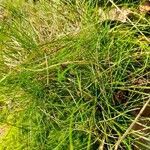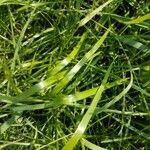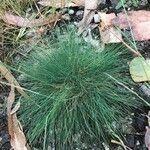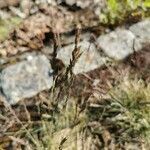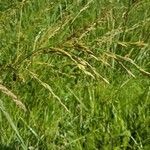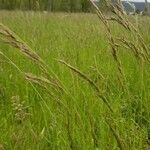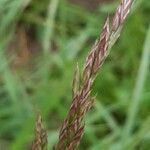Culms glabrous, 3–10 dm, usually loosely tufted, often decumbent at base, frequently rhizomatous; young shoots diverging from the axils and breaking through the base of the sheath; lower sheaths closed and reddish-purple when young, soon disintegrating into loose reddish-brown fibers; blades glabrous, 0.7–2 mm wide, with (3)5 ribs, the sclerenchyma in 7–9(11) discrete strands opposite the veins; infl 5–20 cm, narrow, with ascending branches or in some forms loosely spreading, the lowermost branches (or at least one of them) naked for mostly (4)5 mm below the first pedicel; spikelets 4–7-fld; first glume subulate, 2.6–4.5 mm, the second broader, 3.5–5.5 mm; lemmas 4.8–6.1 mm, the longest awns 1–3 mm; 2n=14, 28, 41, 49, 50, 56, 70. In a wide range of open habitats, widely distributed in n. Europe and in N. Amer., in our range from Que. to Wis., s. to Ga. and Mo.; plants of the coastal region thought to be native, but some or all of the inland forms may be intr. (F. prolifera, a viviparous form with some of the lemmas elongate and foliaceous, occurring from Nf. to the mts. of N. Engl.)
Plants loosely tufted, shortly rhizomatous; shoots extravaginal; basal sheaths reddish brown. Culms 15–60(–100) cm tall, nodes 1–3. Leaf sheaths glabrous or with retrose hairs, occasionally reddish; auricles present as erect swellings or absent; leaf blades setaceous, conduplicate or culm blades flat, 6–30 cm × 0.4–1 mm (to 4 mm when flat), veins 5–7; adaxial to abaxial sclerenchyma strands absent, abaxial sclerenchyma in narrow discrete strands; ligule 0.1–0.5 mm, margin without cilia. Panicle fairly loose, 5–14(–20) cm; branches 1.5–8 cm, scabrid or hairy, 1–4 at lowest node. Spikelets 6–13 mm, green or purple; florets 2–6(–10); glumes smooth or slightly scabrid; lower glume narrowly lanceolate, 2–3.5(–4.5) mm; upper glume broadly lanceolate, 3.5–5.5(–6) mm; rachilla internodes ca. 0.8 mm, pubescent; lemmas smooth, scabrid or pubescent, (4–)5–7(–8) mm; awns (0.3–)1–3.5(–5) mm, rarely awnless; palea keels scabrid toward apex. Anthers (1–)2–3.7 mm. Ovary apex glabrous. 2n = 14, 21, 28, 42, 49, 53, 56, 64, 70.
Perennial, rhizomatous and caespitose. Culms 25–104 cm high, slender. Young shoots extravaginal. Leaves: basal sheath margins connate; ligule a narrow rim, 0.2–0.4 mm long; auricles absent; basal leaf blade usually closely folded or involute, angled, filiform, 3.5–38 cm long, 0.4–0.9 mm wide (not flattened out), cauline leaves usually less strongly folded, adaxially puberulous. Panicles somewhat contracted, 7–14.5 cm long. Spikelets 6.4–11 mm long, with 3–7 bisexual florets. Glumes: lower glume 2.1–3.8 (–4.3) mm long, 1-nerved; upper glume 3.4–5.5 mm long. Lemma dorsally compressed, 4.7–6.4 mm long, acuminate or acute, shortly awned, obscurely 5-nerved, with at least midnerve minutely scabrous toward apex; awn apical, 0.8–3.4 mm long. Caryopsis ellipsoid.
